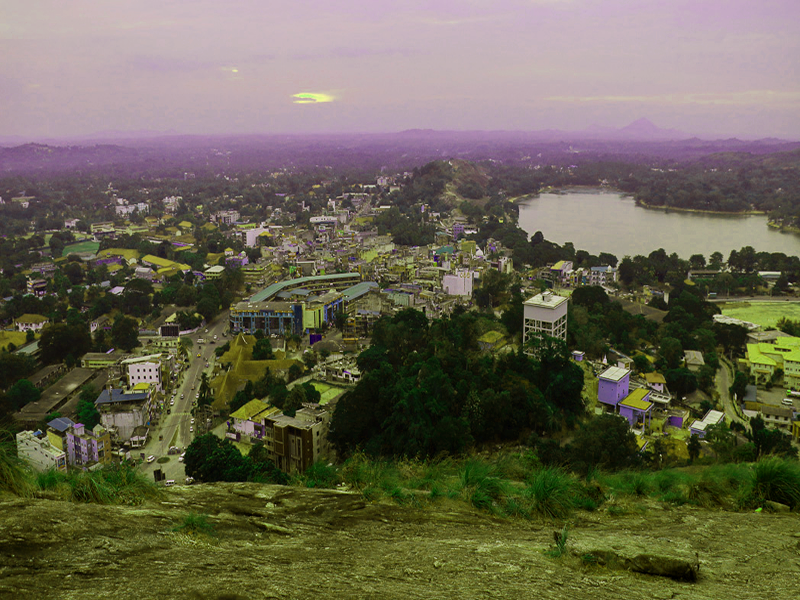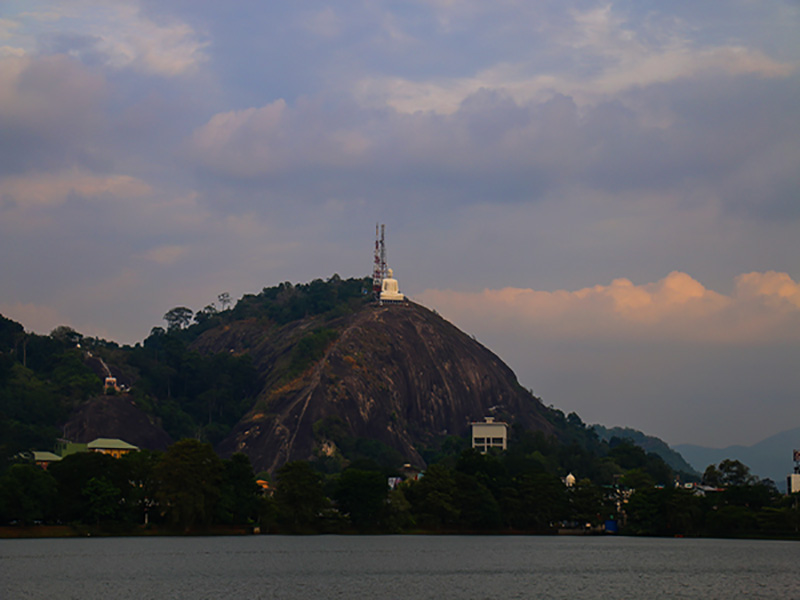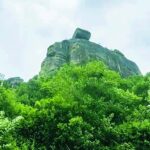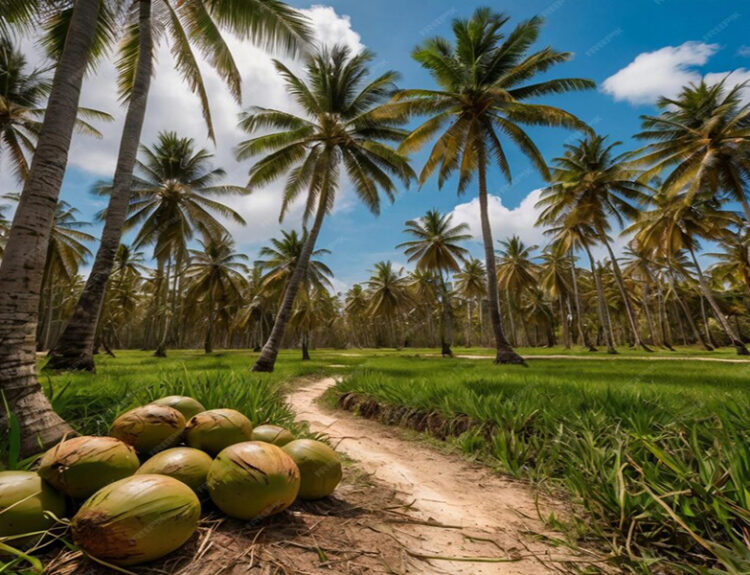Welcome to the “Rock of Legends Series,” where we will delve into the captivating world of Sri Lanka’s ancient rock formations. In this series, we will explore the rich history, cultural significance, and natural beauty of these iconic landmarks. Our first stop: Athugala, the majestic Elephant Rock.
Athugala, a prominent feature of the Kurunegala District, is a testament to nature’s artistry. Its distinctive shape, resembling a colossal elephant, has captivated visitors for centuries. Beyond its striking appearance, Athugala holds deep historical and cultural significance.
Ancient inscriptions and remnants of bygone civilizations adorn the rock, offering glimpses into Sri Lanka’s rich past. The serene temple complex at the summit provides a tranquil space for meditation and reflection, while the panoramic views of the surrounding countryside are simply breathtaking.
As you ascend the slopes of Athugala, you’ll be immersed in a world of natural beauty and historical intrigue. This iconic landmark invites you to explore its hidden depths and uncover the stories it has to tell.
Athugala, also known as the Elephant Rock, is a prominent landmark in the Kurunegala District of Sri Lanka. 1 It’s named for its distinctive shape, which resembles a crouching elephant. 2 This majestic rock formation offers stunning panoramic views of the surrounding countryside.
While the specific historical origins of Athugala, or the Elephant Rock, remain somewhat obscure, it is clear that this majestic formation has been a significant landmark in the Kurunegala District for centuries. Its distinctive shape, resembling a colossal elephant, has captured the imagination of people for generations.
The name “Athugala” is derived from the Sinhala word “අලියා,” which means “elephant.” The rock formation’s distinctive shape, resembling a colossal elephant, has earned it this name. The local population, recognizing the striking resemblance, has naturally adopted this name over time.
The rock’s distinctive shape, resembling a colossal elephant, has captured the imagination of people for generations.
This striking resemblance has led to its popular name, “Athugala,” which translates to “Elephant Rock” in Sinhala
Athugala, or the Elephant Rock, is a majestic landmark in the Kurunegala District of Sri Lanka. Its distinctive shape, resembling a colossal elephant, has captivated visitors for centuries. The rock formation is steeped in history and legend, with ancient inscriptions and temple ruins adorning its slopes. The climb to the summit offers breathtaking panoramic views of the surrounding countryside. Beyond its historical significance, Athugala is a testament to the power of nature, showcasing the unique geological formations that shape Sri Lanka’s landscape.
The name “Kurunegala” is derived from the Sinhala words “Kuruna” meaning “tusker” or “elephant with protruding teeth” and “Gala” meaning “rock.” This name refers to the iconic Athugala rock formation, which resembles a colossal elephant.The ancient name for Kurunegala, “Hasthishaila-pura,” translates to “City of the Elephant Rock” in Sanskrit. This further underscores the significance of the rock formation in the city’s history and identity. The ancient name for Kurunegala, “Hasthishaila-pura,” translates to “City of the Elephant Rock” in Sanskrit. This further underscores the significance of the rock formation in the city’s history and identity.
significance, and natural beautycultural
- Majestic Rock Formation: Athugala, or Elephant Rock, is renowned for its distinctive shape, resembling a colossal elephant. This natural wonder offers breathtaking panoramic views of the surrounding countryside.
- Serene Environment: The tranquil atmosphere, coupled with the lush greenery and fresh air, makes it an ideal spot for relaxation and meditation.
- Perfect for Adventure: The climb to the summit, though challenging, rewards visitors with stunning vistas and a sense of accomplishment.
Cultural Significance
- Historical Importance: The rock has been associated with various legends and folklore, adding to its mystique. Ancient inscriptions and remnants of bygone civilizations found on the rock attest to its historical significance.
- Religious Significance: The presence of a temple complex at the summit highlights the spiritual importance of the site. Visitors can experience the serene ambiance and pay homage to the Buddha statue.
- Cultural Symbolism: The elephant, a revered animal in Sri Lankan culture, is often associated with wisdom, strength, and good fortune. Athugala’s elephant-like shape further reinforces its cultural significance.
The Special Features of Athugala
Athugala, or the Elephant Rock, is a prominent landmark in the Kurunegala District of Sri Lanka. Its unique shape, resembling a colossal elephant, is the most striking feature that sets it apart. Here are some of the special features of this majestic rock formation:
- Distinctive Shape: The rock’s elephant-like silhouette is its most recognizable feature. This natural wonder has captivated visitors for centuries.
- Panoramic Views: From the summit of Athugala, visitors can enjoy breathtaking panoramic views of the surrounding countryside. The picturesque landscape, dotted with lush greenery and distant hills, offers a serene and inspiring sight.
- Historical Significance: The rock is believed to have historical and cultural significance, with ancient inscriptions and remnants of bygone civilizations found on its surface.
- Religious Importance: The presence of a temple complex at the summit adds to the spiritual significance of Athugala. The temple houses a large Buddha statue and offers a peaceful retreat for visitors.
- Natural Beauty: The surrounding natural environment, with its lush vegetation and diverse flora and fauna, enhances the overall experience.
Athugala, or the Elephant Rock, is a majestic landmark in the Kurunegala District of Sri Lanka. Its distinctive shape, resembling a colossal elephant, has captivated visitors for centuries. The rock formation, with its ancient inscriptions and temple ruins, offers a glimpse into the rich history and cultural heritage of the region. The climb to the summit is a rewarding experience, offering panoramic views of the surrounding countryside.

The rock’s unique shape has not only made it a popular tourist destination but also a significant cultural and historical site. Ancient inscriptions and remnants of bygone civilizations adorn the rock, hinting at its deep-rooted connection to the past. A serene temple complex, housing a magnificent Buddha statue, crowns the summit, offering a peaceful retreat and spiritual solace
The climb to the summit of Athugala offers a rewarding experience, with breathtaking panoramic views of the surrounding countryside. The ancient temple complex at the top, adorned with intricate carvings and housing a magnificent Buddha statue, adds to the spiritual significance of the site.
While the exact origins of Athugala remain shrouded in mystery, it is believed to have been a place of worship and meditation for centuries. The rock’s unique shape and serene atmosphere have made it a popular pilgrimage site for Buddhists.
Whether you’re a history buff, a nature lover, or simply seeking a peaceful retreat, Athugala offers a unique and unforgettable experience.
Prepare to be captivated by the “Elephant Rock Chronicles” series! Over the next few articles, we’ll delve into the mysteries of Athugala, a majestic rock formation steeped in history and legend. We’ll explore its unique shape, cultural significance, and the breathtaking views it offers. Join us on a journey to uncover the secrets of this ancient landmark and experience the magic of Sri Lanka’s natural beauty.






